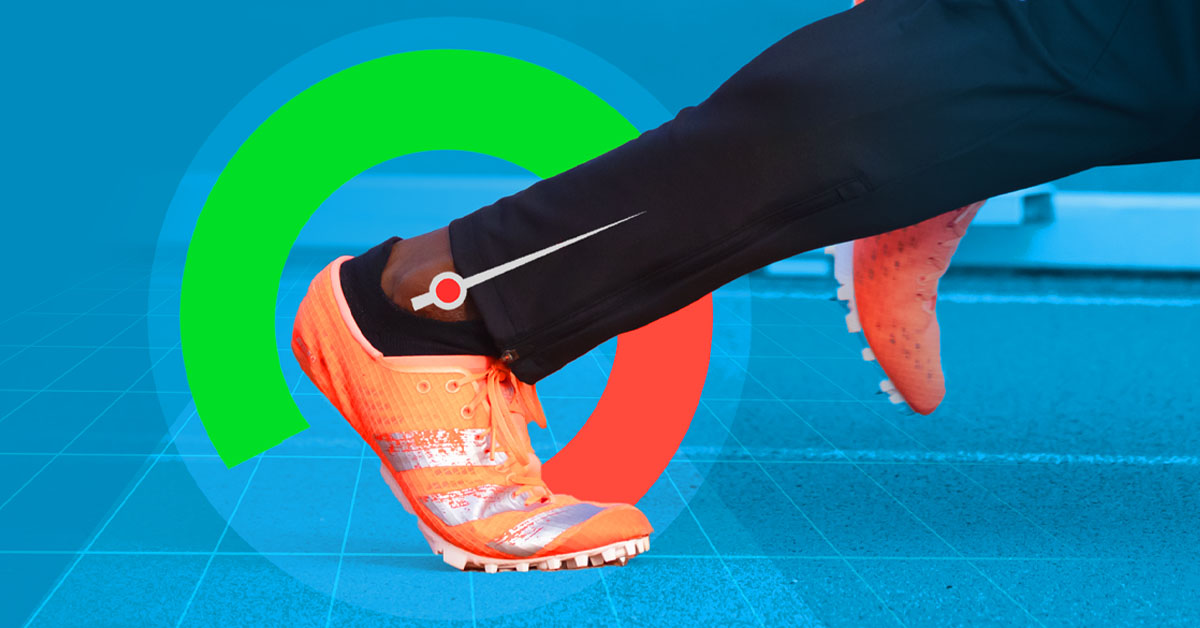
This is the definitive guide on sprinting technique. You'll learn how to sprint faster and master proper sprinting form in five steps.
We’re going to give you a detailed step by step approach based on the latest scientific research and the fastest athletes on the planet.
The sprinting technique covered in this guide has been proven to dramatically increase speed across a wide range of sports.
Whether you’re a:
- Track and field coach or athlete looking to take a second off of a 100 meter time.
- A football player wanting to improve your 40 yard dash.
- Someone that wants to incorporate speed work and sprinting into your training routine.
The tactics and information provided here will teach you how to sprint faster.
You’ll get insight and demonstrations from Olympian Jeremy Dodson, elite sprinting coaches Karim Abdel Wahab and Ken Harnden.
So if you want to learn how to develop speed with proper sprinting form, this is the guide.
Chapter 1: The skill of sprinting
Sprinting is a skill which means you can train your body to be significantly faster.
Like any skill, it takes practice and time to learn and develop the proper sprinting technique.
However…
Sprinting isn’t just “running faster.”
Understanding the difference between sprinting and running technique is critical.
Sprinting is about applying the maximum amount of force down to the ground.
Watch this short video comparing distance running form to sprinting:
Despite the different camera angles and frame rates - the contrast in technique is clear. Notice the differences in thigh angle, arm action, body position and stride length.
Concept #1 - You Can Learn Speed
The notion of “You Can't Teach Speed” is simply not true.
Speed is not something you either have or you don’t. If you put in the work and develop the right technique you will learn how to sprint faster.
Of course your genetic make-up is a major factor when it comes to your performance ceiling and ability to compete at an elite level.
But even the most gifted athletes have to learn the correct sprinting technique and spend countless hours refining it.
Christian Coleman is a former USA and World Champion and it’s rare to read an interview where he doesn’t talk about the amount of work he puts in.
It’s true that the fastest people on the planet all won the “genetic lottery.” That doesn’t mean that speed is unteachable.
You can’t change your DNA (as of this writing) to become a world class sprinter.
But you can change your technique and training to maximize your individual potential and sprint faster. And along the way, you’ll unlock a wide range of physical benefits, check out our article on how sprint training transforms your body to learn more.
Concept #2 - Sprinting Is A Motor Learning Skill
Motor learning or “motor skill learning” is typically defined as "the process by which movements are executed more quickly and accurately with practice."
Think of a pitcher practicing a curve ball or a basketball player working on free throws. It takes a lot of specific practice to become great.
The same idea applies to sprinting. This means we can train the nervous system and muscles to react and move in a way that produces optimal speed.
This philosophy and approach is very different compared to typical sprint training.
Many athletes and coaches believe that the way to get faster and develop speed is to just spend a lot of time sprinting. In theory this makes sense.
When it comes to endurance running and fitness, more miles and training typically leads to a better aerobic capacity and faster times (to a point).
However, sprinting isn’t just “running faster.” After a certain point, speed doesn’t improve with repetitions and time spent on the track. Why? Because the technique and biomechanics of sprinting is very different than running.
Listen to coach Karim's approach to sprint training in the short clip below:
Optimal sprinting technique and posture doesn’t come naturally and must be developed.
On the surface, good running and proper sprinting form share some commonalities.
Both require a neutral pelvis, head looking forward, tall posture, foot strike to be underneath the center of mass etc. But dig a little deeper and the differences become very apparent.
The role of technique is substantially more important in sprinting vs running. The body angles, ground contact time, arm movement and foot strike are totally different.
Because sprinting is so technical, many top athletes use additional techniques like mental practice to visualize and improve their form.
Sprint training programs are also much different than endurance running programs. One of the key differences is the amount of time dedicated to developing and maintaining sprinting technique.
Trying to learn how to sprint faster without understanding and practicing correct sprinting technique only serves to reinforce bad habits.
A Revolutionary Approach To Learning Elite Sprinting Technique
Explore CourseConcept #3 - Sprinting Is All About Force Production
Sprinting faster is about applying the maximum amount of force down to the ground.
The more force you can apply to ground the faster you will go.
The fastest sprinters on the planet produce 5 times more vertical force into the ground compared to slower ones.
Researchers that analyzed Usain Bolt estimated that he is able to produce over 1000 pounds of force down to the ground!
The 3 ways to maximize force application are:
- Proper sprinting form/posture
- Proper sprinting mechanics
- Proper sprinting rhythm
This guide is focused on the first point. But keep in mind that all 3 are equally important with regards to learning how to sprint faster.
In order to generate the highest force possible, your sprinting posture or form has to be absolutely solid.
Of course, that solid posture is only effective if your body has the physical capacity to handle those immense forces, which is where dedicated tendon training for speed becomes essential.
Common errors such as being too low or breaking at the waist will seriously limit how fast you can run.
Posture is the foundation that everything else is built upon. Trying to develop great sprinting mechanics and rhythm without good posture won't help you sprint faster.
Everything we are going to cover in the following sections will help to get your form dialed-in.
Solid form leads to solid power.
In the video below Olympian Jeremy Dodson shares some insight on applying force down to the ground:
Chapter 2: Proper Sprinting Form - Step By Step
We’re going to cover the most important aspects of upright sprinting technique from the head down.
The optimal sprinting position is called the "hard post."
If you want some great drills to develop the hard post and sprinting posture make sure to check out our free Speed Primer course.
Remember that each athlete is unique. What works for you may differ slightly from some of the recommendations.
Christian Coleman has different form compared to Usain Bolt. The key is that they both put themselves in a position to apply maximum force down to the ground.
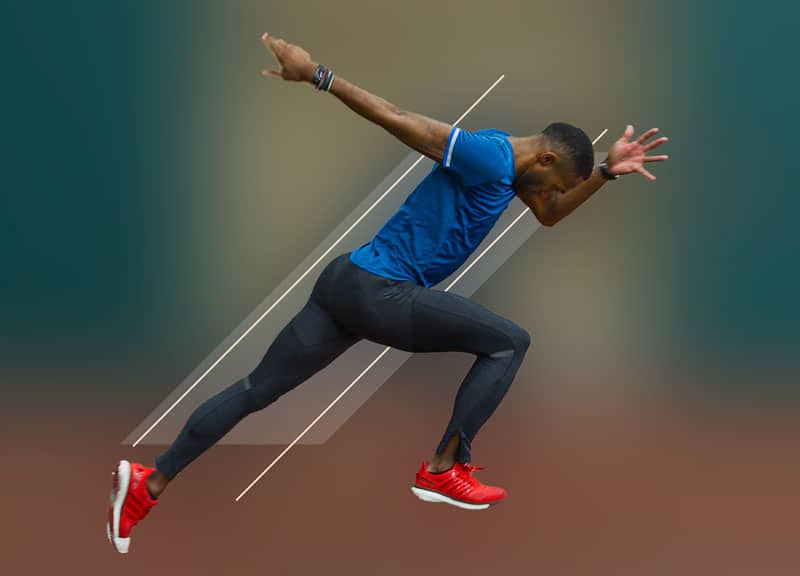
Great example of the "hard post." The back leg forms a straight line through the torso to the head. The upper body is tall and directly over the hips. The shin angle of the lead leg mirrors the rear leg.
Step 1 - Upper-Body Posture
During upright sprinting the posture should be tall with the head, neck and shoulders directly on top of the hips. Anything more than a very slight forward lean will move everything out of position.
To learn about posture and positions out of the starting blocks check out this guide on block starts.
The shoulders are relaxed and down.
This allows foot placement and force application to be vertical (think of marching in place).
Being broken at the waist or leaning too far forward will drastically reduce your ability to apply force straight down to the ground. Less vertical force = slower sprinting.
In the video below Olympian Janay DeLoach Soukup demonstrates the marching action and how it converts to sprinting.
Her upper-body is tall, head looking forward, everything is aligned on top of the hips. These positions directly translate into proper sprinting form.
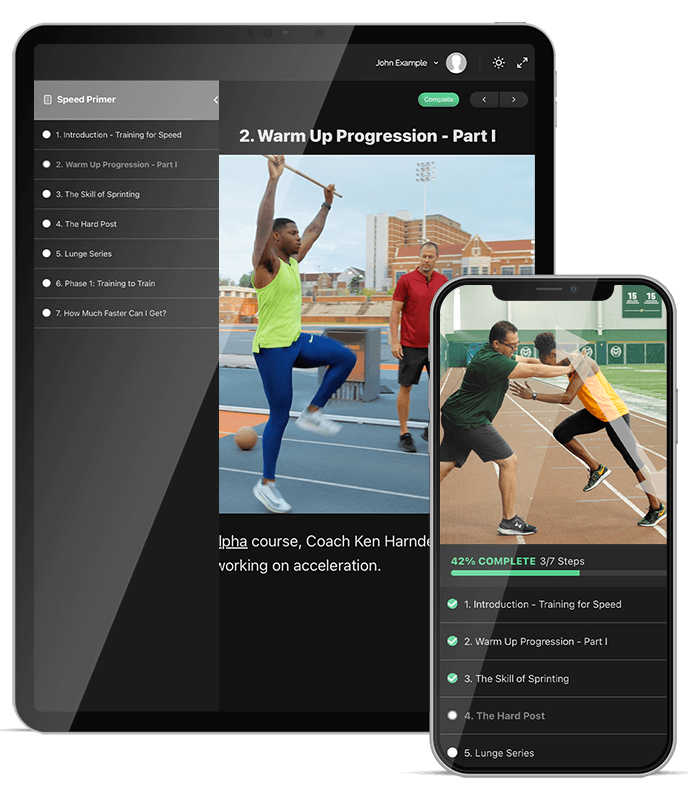
Step 2 - Sprinting Arm Action
Arm action plays a critical role in proper sprinting technique. Correct sprinting arm movement balances the body, promotes rhythm and increases force production.
Should you lock your arms at a fixed angle? It turns out the answer isn't as straight forward as you would think.
Many coaches and articles say things like “keep your arms at 90 degrees” or “lock the elbows.”
The theory being that a bent arm moves faster and will decrease the flight phase (when both feet are off the ground) of the sprint.
While other coaches insist that extending the rear arm will provide additional speed. They argue that instead of locking the elbows and arms in a fixed position, the arms should work in harmony with what the legs are doing.
Regardless of which camp they are in, all sprint coaches can agree that the arms move front to back (or on the sagittal plane) with virtually no movement side to side.
The legs will follow what the arms do. So crossing the arms will lead to unnecessary lateral movement.
Any movement not towards the finish line prevents you from achieving optimal acceleration and max velocity during the sprint.
The arms should also be relatively free of tension and fluid. Over-tightness in the arms will flow to the legs and slow you down.
If you want to experiment with option 2 (arm extension)
The hand should be blocked around shoulder height (meaning it does not extend pass this point).
The action of the arm should be a 1 stroke movement.
Once the hand reaches shoulder height, strike down and back with the arm.
As soon as ground contact is made with the foot, the hand should swing past the hips with the elbow near complete extension (almost straight).

Once the arm swings behind the body the elbow will rebound to around 105 degrees so you can see daylight between the rear arm and torso.
By extending the arm in this manner behind the body the spine is able to properly rotate which increases power.
This arm movement will also cause a stretch in the chest and shoulder.
This stretch creates “an elastic energy return” of the arm back to the front of the body. This means less effort is required to drive the arm forward to the starting ‘blocking position’ of shoulder height.
If you want to experiment with option 1 (fixed angle)
The video below provides some great insight and compelling logic as to why you should keep the arms locked (if you have enough power).
As with many things in sport, there isn't a definitive answer that will work for every athlete.
Step 3 - Lower Body Positions
If the upper body and arm movement is dialed in it will be much easier to hit the proper positions with the lower body.
Remember, the goal of sprinting is to provide maximum vertical force to the ground.
In order to achieve that force, the pelvis or hips should be neutral (not tilting forward or backwards).
This will create a stretch across the hip flexor muscles during the stride. Similar to the stretch of the arms, this will allow for an elastic return of the thigh to the front side of the body.
To sprint fast you need to have the foot land directly underneath the center of mass. Think of stepping over the knee and driving the foot straight down into the track.
Longer strides should be the result of applying more force to the ground which will automatically propel you forward.
Many athletes make the mistake of trying to cover more ground by lengthening their stride.
This is a mistake and should avoided at all costs.
Olympic Sprinting coach Ken Harnden spends a ton of time on stride length and ground contact with his athletes. It's also a major area of focus in his sprinting master class Sprinting Smarter, Speed Progression.
Over-striding or “reaching” is a killer when it comes to how to sprint faster.
The reason is because when you reach out for a longer stride you are going against your inertia. It's like putting on the brakes every time your foot hits the ground.
Each stride will also be less powerful if it lands in front of the body.
You won't be in a position to fully utilize the strength of the quads and gluteus muscles. Reaching also puts unnecessary stress on the hamstrings.
Instead focus on pushing down to the track or ground with a neutral pelvis. Watch where the foot lands in relation to the body in the video below. Both athletes have a great stride length without reaching.
Step 4 - Leg Movement Positions
The lead leg should follow a 2 stroke movement.
The first movement is up to form the “ hard Z.” (see video below).
The foot is behind the knee and the calf is close to the hamstring. This is much faster than an “L” position where the calf is perpendicular to the ground.
The second movement is an active strike directly down to the ground. As soon as you hit the “hard Z” immediately explode down to the ground. Don't wait.
Just changing this single element of your sprinting technique should have a sizable impact on your speed.
Fast sprinters spend less time on the ground with each stride vs slower ones.
A big part of that quick ground contact is achieved through an active strike to the ground.
The video below will give you a good idea what the "hard Z" should look like:
Step 5 - Ground Contact
Don’t run on your toes!
If you try to run on your toes what ends up happening is a collapsing of the ankle once the foot hits the ground. This will increase ground contact time and lead to slower speeds.
Instead the foot should be “dorsiflexed” which is having the toe close to the shin.
This creates another stretch reflex where the stored energy will act like a spring once your foot hits the ground.
The fastest sprinters on the planet have extremely short ground contact times during upright sprinting.
The top male sprinters in the world are on and off the ground in less than .09 seconds when sprinting at top end speed. The fastest females take just slightly longer.
Ground contact is an area that coach Karim spends a considerable amount of time discussing in "Sprinting Smarter, Sprinting Faster." It's a big deal when it comes to learning how to sprint faster.
The actual contact point is on the forefoot (where the spikes are on track shoes).
There are several drills that train the body and nervous system for proper ground contact. Different types of A-Skips, B-Skips, and various plyometric drills such as box jumps.
When done correctly, performing high-value sprinting drills will translate to faster speed on the track.
Putting it all together
Last but not least - this video provides a fantastic overview of the top 5 sprinting tips taught by coach Ken Harnden.
You'll see the concepts from this article put into action with additional insight and slow motion demonstrations.
Now It's Your Turn
We've covered the main technical elements of developing proper sprinting form and posture.
Of course there is a lot more that goes into maximizing speed. But your posture is the foundation that everything is built upon.
Once you get your posture dialed-in, the quality of your training and sprinting will improve dramatically.
If you're looking for a complete program designed for coaches and athletes to dramatically improve sprinting technique and speed, check out Sprinting Smarter, Sprinting Faster.

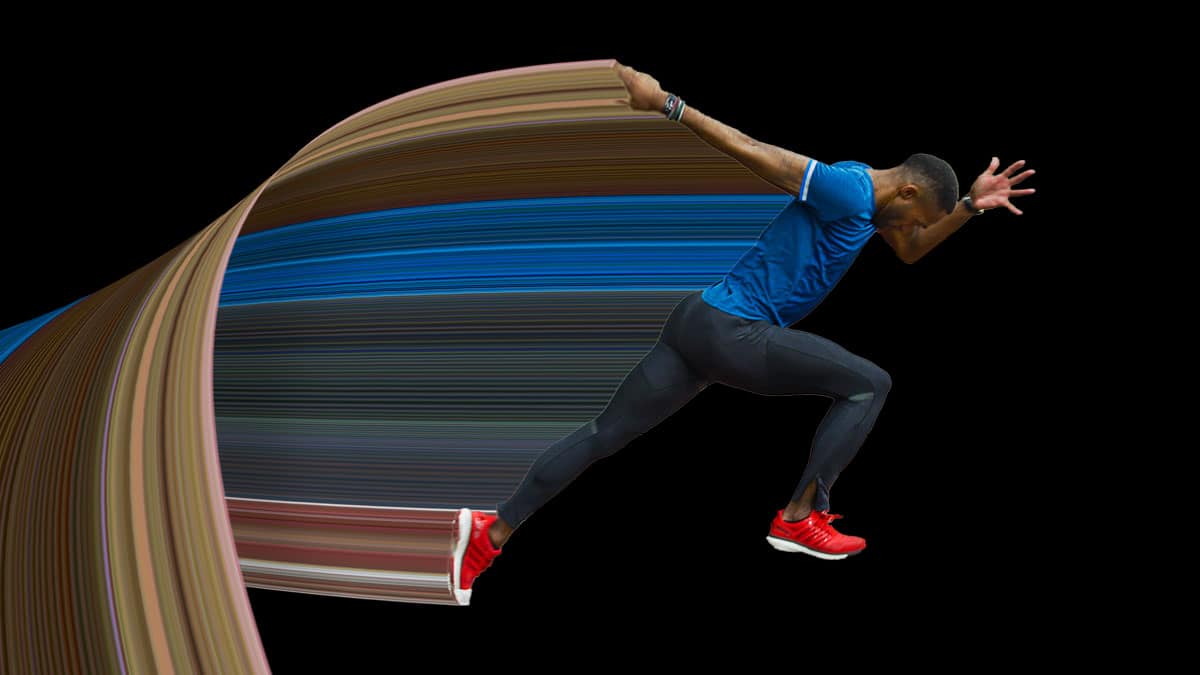
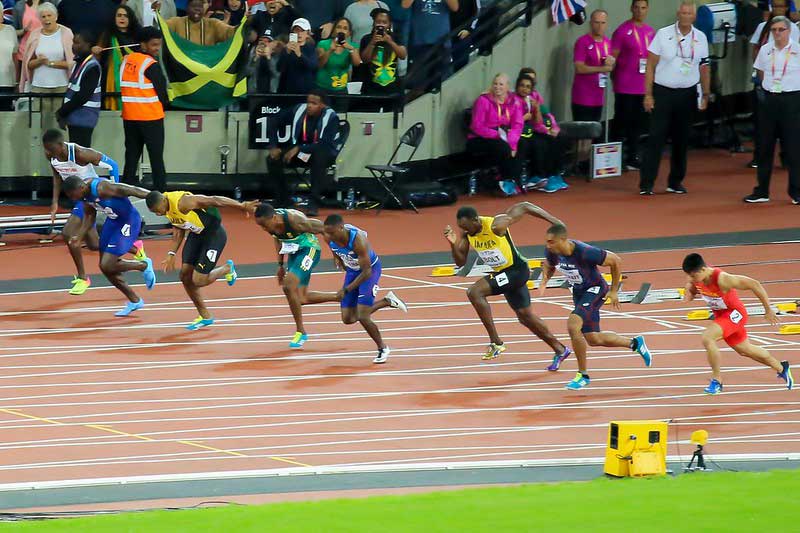
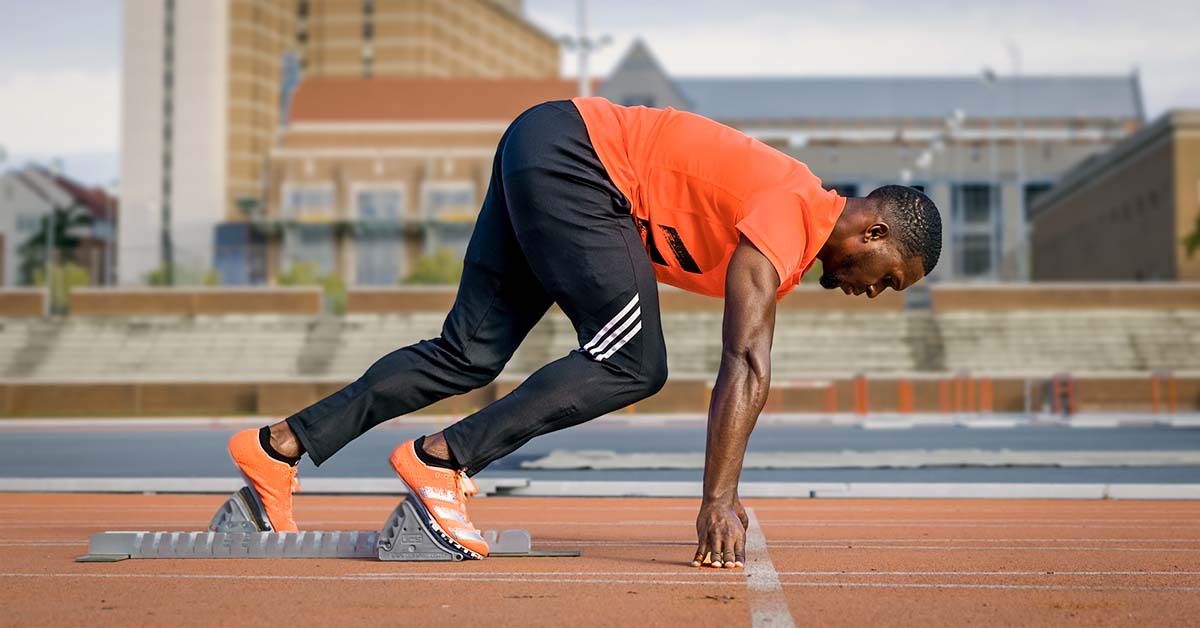

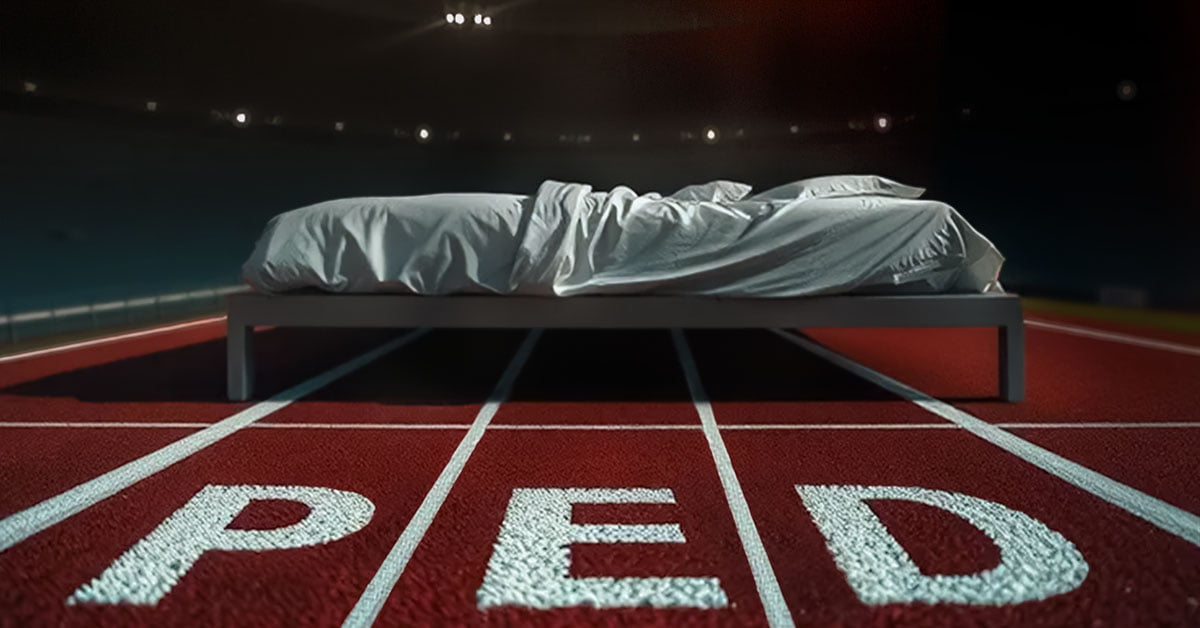
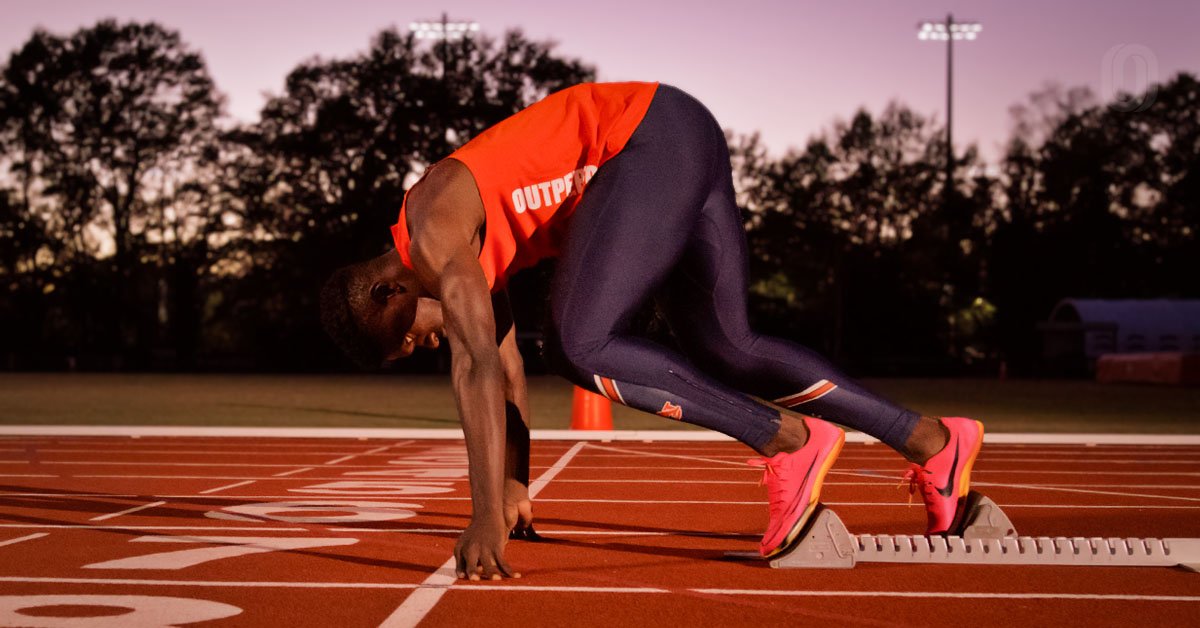
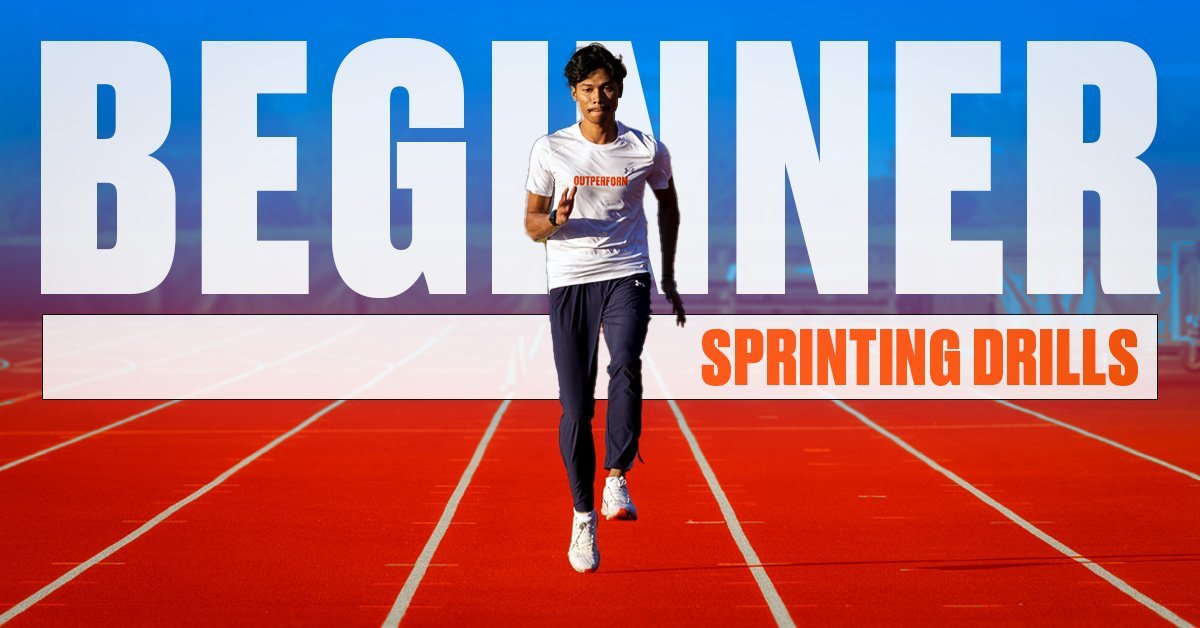

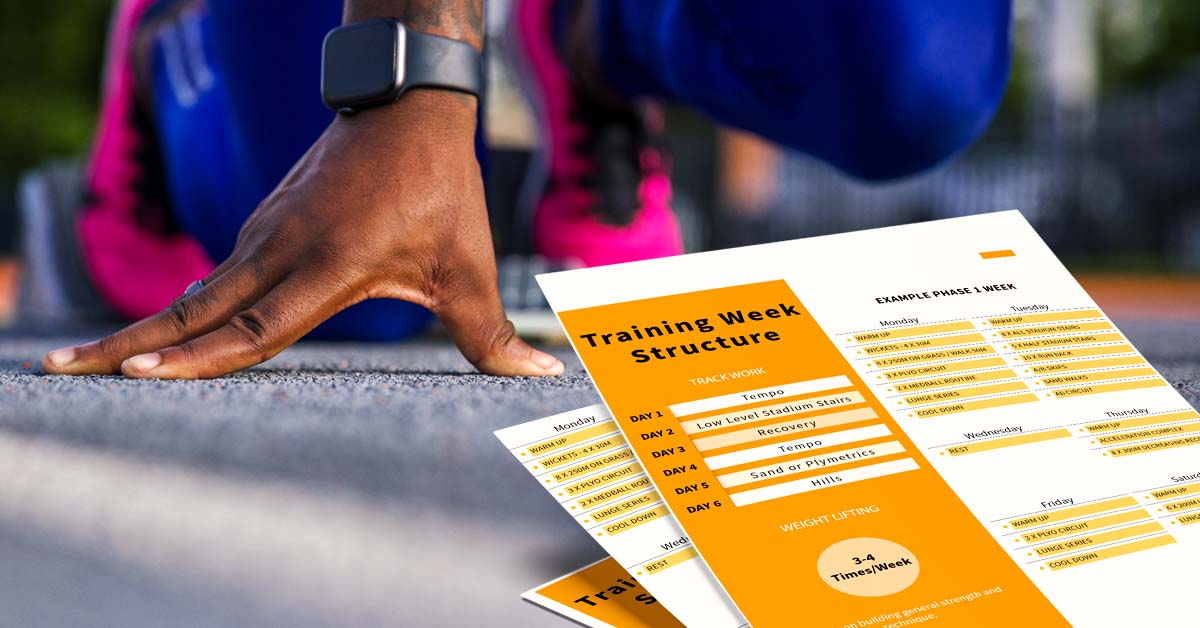
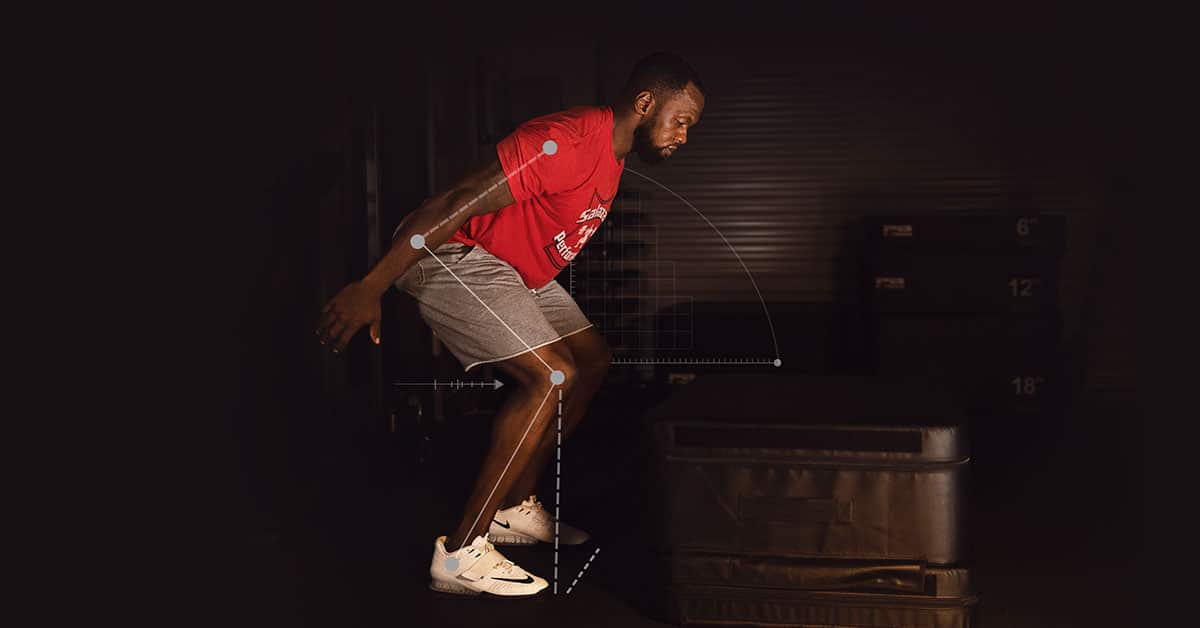
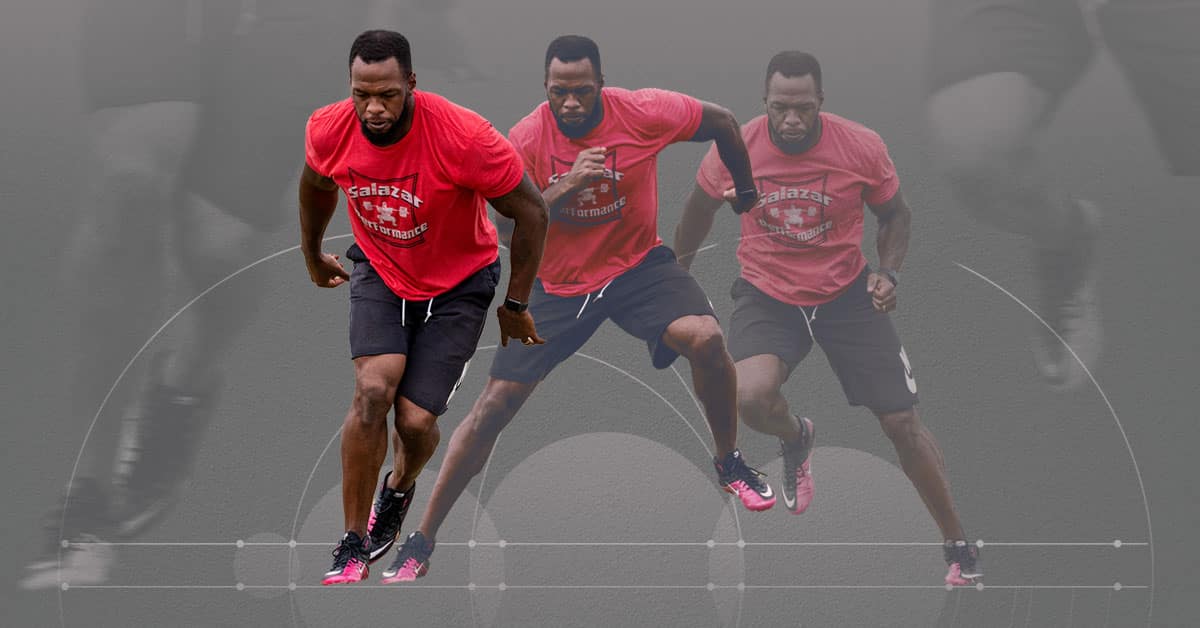
Fantastic as usual.
Good materials, gonna study all this and put in practice as I already being doing based on your videos.
Heck yeah, thanks Rossano!
Great review. I am a male who is 72 years of age. I have never trained or ran sprints until a few months ago with my primary goal being to compete in the 70 to 74 year Senior Olympic age group. Watching and reading the information above made it very clear that i have much to learn.
I very much enjoyed and appreciate all of the proper form and training that this article describes. You did it in a manner that was clear and easy for a novice to understand. Thank you .
Sincerely Claude
Great job !
Appreciate the kind words Claude! Really great to hear. Best of luck with your training and let us know how it goes once competition resumes.
Great info, I have a background in barbell training and combat sports, however I detest steady state cardio and I needed more conditioning to combat the middle aged weight gain. Over the covid curfew I decided to do what I been talking for years-sprint. I started on the 40 yd incline in my parking garage and have been using vid on youtube to self coach and avoid injury. . I like this comprehensive page because as I progressed and became more educated I realized I had questions on drive, foot strike and posture. This gives me good info to progress..safely. I am quite aware that trying to move a 45y/o, 200lb frame in a sprint can really pull something lol
I'm looking forward to receiving DVD. In just reviewing and applying technique from your YouTube videos,the next day I was able to surge another 5 mph beyond my maximum uphill intervals ! I'm a 1500 meter runner looking to improve my surge and kick and maximum speed. I have recently converted well to midfoot strike (with light heel touch) from the hell of heel striking (ughh- injuries). My cadence is very high (200-240)in 400M, but stride length low. So I need drills, strength and flexibility to drive glutes and achieve good escape velocity and stride length.Thanks. Can't wait!
Thanks for the comment Christopher, that is great to hear! The course will certainly help you develop your stride. I sent you an email about accessing the course (it's digital vs DVD). Keep us updated on your progress!
Hey guys my name is Oscar, I'm an 18 year old spanish athlete and here's my problem.
The thing is that I'm a very powerful sprinter, but my problem is that all that force is aplied to the ground in the wrong way because my steps are too loud, my coach says that that i aply so much force to the track that I could be losing about half a second and even a second in my runs, and i don't know how to correct that, any guesses? I would apreciate a lot that you guys reply to me.
Looking forward to hear from you, have a good one
Hi Oscar. the good news is that there is no such thing as applying too much force down to the ground. Usain Bolt has been studied and researchers found he could produce about 1000 pounds of force with each stride! So you want to keep your force production as high as possible. It sounds like there may be other areas of your technique to improve if your feet are making a loud sound. Look at where your foot is contacting the ground (in front, underneath center of mass etc.) Look at how your foot is contacting the ground and where you are landing. Look at your posture - is your back straight and are you hitting the "hard post."
Other areas to check are stride length vs frequency.
We're about to release a new sprinting course this month that goes into great detail concerning these areas. Let me know if you are interested and I'll send you a discount code. Good Luck!
Good teaching guide to apply to our young and potentials. Would like to appeal for more guides in Running Techniques and Running Form
Good article. Is this equally helpful for kids of age 7 - 9 years as well for making them the future best sprinters? What additional pre and post drills are necessary to bring perfection of good body postures? Thanks for all great information.
Hello Hansraj, thanks for the question. Yes, they will most certainly help kids 7-9, getting good habits established early is key to sprinting success as they mature. Check out our free videos for more drills that help with posture and of course our sprinting master classes (Speed Progression and Sprinting Smarter) include a ton of drills that address all aspects of sprinting.
Very technical and rather easy to Grasp is the article. in fact the focus on my biggest and historical problem overstride has plagued me more than age and and only average genetics. Hamstring issues rather than years of abusing the body through rough stock rodeo events and violent collisions playing American football. However I'd rather run sprints till I through up get the second wind and go back for more as opposed to both boring distance,trail runs or worse
Great training video!
Great post
So interesting to hear sprinting being broken down. I am trying to coach children to sprint correctly
Thanks John! Hopefully this helped, teaching children sprinting technique can be challenging.
You might be interested in a new course that is fantastic for teaching young athletes how to properly sprint called 'Smarter Athletic Speed.'
Coach Ken Harnden does a great job of simplifying the concepts and gives a ton of actionable insight.
I need to learn to apply more force to the track
Spot on! I have a freshman sprinter who is fast but doesn't have the posture yet. I'm dad and I've been getting him by with his natural atheltic ability. Time to step up.
Great to hear Kevin!
Great post! I've been struggling with my sprinting form for a while now, and these tips have already helped me improve my speed and efficiency. Can't wait to see the results in my next race. Thanks for sharing!
I purchased your course on sprinting and have found it to be most informative. My english and latin teacher between 1973 and 1978 taught me everything I knew about sprinting from 2011 to 2021 when he sadly died while sprinting at the age of 73. Before he died he had passed on the 'coach' title to me in helping young sprinters in Killorglin, Co. Kerry, Ireland reach their full potential. Since then I have used courses like yours to help me become a better coach. Please give me details about the new course on sprinting you have put together.
John, thank you for sharing your journey and dedication to coaching young sprinters in Killorglin. It’s heartwarming to hear about the legacy passed down to you and your efforts to honor it and knowing our courses helped you with that mission.
Regarding the new sprinting course, Sprinting Drills Alpha, you'll get comprehensive training on a variety of sprinting techniques and drills, including effective warm-up sequences, maintaining optimal ground contact, and improving acceleration. It covers proper body alignment, efficient sprinting mechanics, and max velocity drills, along with reaction time, sprinting plyometrics, and resisted sprints. Led by Olympian and NCAA champion Ken Harnden. If you have any other questions please let us know. Thanks John!